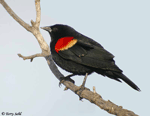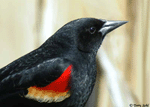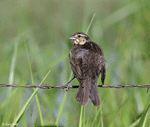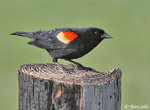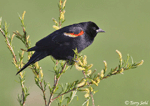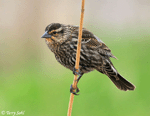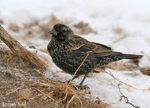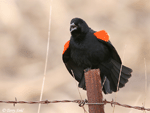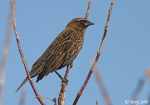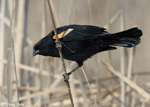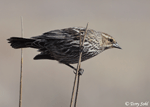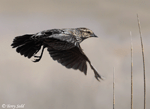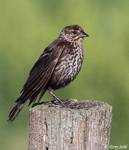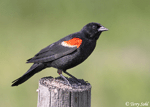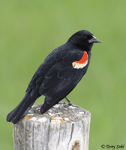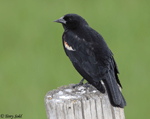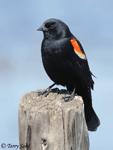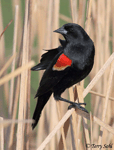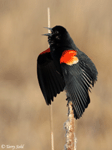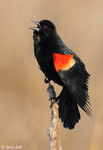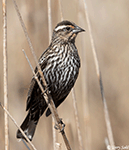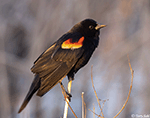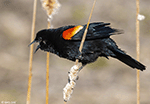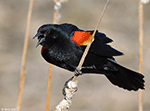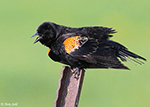| Length: 7.5 - 9 inches | Wingspan: 12 - 14 inches | Seasonality: Summer / All Seasons |
| ID Keys: Males red overall with red shoulder patches. Females heavily streaked with brown and dusky white. | ||
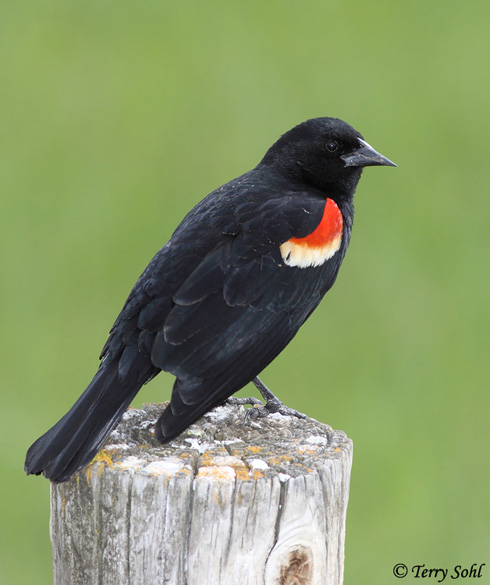 Red-winged Blackbirds are
one of the most abundant
birds in the state during the summer months. They can seemingly be found in just about every marsh or
weedy ditch, particularly in the eastern part of the state. The colorful males (photo on
the right) can often be seen perched on high perches, singing their song and
defending their territory. The less colorful females (see photos at the
bottom of the page) are often not as visible as they stay hidden in vegetation.
The males in South Dakota appear as in the photo to the right and the photos
below, with the prominent red wing patch edged with a yellowish color. Male
Red-winged Blackbirds in some areas lack the lighter colored fringe (primarily
birds in the far southwestern US and in Mexico). Red-winged Blackbirds are
somewhat more dispersed during the summer breeding season, but are much more
gregarious during migration and in the winter, when flocks of mixed blackbird
species may number in the many thousands.
Red-winged Blackbirds are
one of the most abundant
birds in the state during the summer months. They can seemingly be found in just about every marsh or
weedy ditch, particularly in the eastern part of the state. The colorful males (photo on
the right) can often be seen perched on high perches, singing their song and
defending their territory. The less colorful females (see photos at the
bottom of the page) are often not as visible as they stay hidden in vegetation.
The males in South Dakota appear as in the photo to the right and the photos
below, with the prominent red wing patch edged with a yellowish color. Male
Red-winged Blackbirds in some areas lack the lighter colored fringe (primarily
birds in the far southwestern US and in Mexico). Red-winged Blackbirds are
somewhat more dispersed during the summer breeding season, but are much more
gregarious during migration and in the winter, when flocks of mixed blackbird
species may number in the many thousands.
Habitat:
They are most commonly found in wet areas such as marshes, swamps, wet meadows, and wet thickets. They will sometimes also be found around lightly wooded riparian areas with surrounding open land. Very adaptable, they've also learned to utilize man-made areas, feeding heavily on waste grain in many areas, and often frequenting feedlots.
Diet:
Mostly insects and seeds. Many insects in the summer, but the majority of the diet is seeds and waste grain during the winter months. Some consider them an agricultural pest, particularly as they will feed on actively growing sunflowers.
Behavior:
Usually forages by walking along the ground in search of seeds and insects. They will also forage low in vegetation.
Nesting:
Mid-May through August. The nest of a Red-winged Blackbird is an open cup of grasses, reeds, and other plant material, built in wetland vegetation such as cattails. The female usually lays 3 or 4 eggs, and she alone incubates them. Upon hatching, both parents feed the young. The young leave the nest after about 2 weeks.
Song:
The song of a Red-winged Blackbird is the classic Conk-a-REEEEE!! They also have multiple chek or chit calls.
- Click here to hear the song of a Red-winged Blackbird, recorded in Sonora, Mexico.1
- Click here to hear the short calls of a Red-winged Blackbird, recorded near Columbus, Ohio.2
Migration:
Summers throughout much of North America, except rare in Alaska and in northern Canada. Populations in Canada and the northern tier of U.S. states typically migrate southward in the fall, although they are present all year in much of the U.S. In South Dakota, numbers do drastically decrease in the winter months. However, a few do stay around in winter. As a personal observation, I've noticed more and more attempting to overwinter in south-central South Dakota, when I take winter birding trips to the Presho/Kennebec/Reliance area.
Interactive eBird Map:
Click here to access an interactive eBird map of Red-winged Blackbird sightings
Similar Species:
The male Red-winged Blackbird in full adult plumage is distinct, as only one other species of blackbird is similar (see Tricolored Blackbird below).
- Tricolored Blackbird - Very similar in overall appearance to the Red-winged Blackbird, the male Tricolored Blackbird has a paler, whitish-colored fringe on the red shoulder patch, compared to a yellower appearance on the male Red-winged Blackbird. In South Dakota and in most of the Red-winged Blackbird's range, differentiating the two species isn't a problem, as Tricolored Blackbirds are only found in California.
- Brewer's Blackbird - Young male Red-winged Blackbirds often have an incomplete or mostly hidden red shoulder patch. They thus often appear to be nearly all black, and could easily be confused with other all black blackbird species such as a male Brewer's Blackbird. With careful observation a young Red-winged Blackbird moving about may show a hint of the red patch when taking flight or otherwise moving its wings. In lieu of identifying the red patch, young male Red-winged Blackbirds often have a "scaly" appearance, compared to a more uniform plumage on male Brewer's Blackbird. Females of the two species could also potentially be confused, as both share the same brownish coloring. However, female Red-winged Blackbirds are much streakier than the more uniformly colored female Brewer's Blackbird.
- Rusty Blackbird - See notes about Brewer's Blackbird above. Rusty Blackbird is another "all dark" plumaged bird (males in breeding plumage) that could potentially be confused with a young "patchless" Red-winged Blackbird.
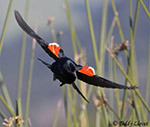 |
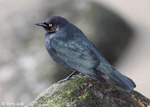 |
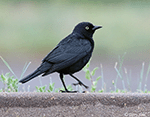 |
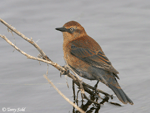 |
| Tricolored Blackbird | Brewer's Blackbird | Brewer's Blackbird | Rusty Blackbird |
Bird Feeders:
Will attend feeders for breadcrumbs and various seeds. In our yard on the edge of Brandon, they don't come to the feeders often, but during spring snow storms they often show up at the sunflower seed feeder, and also show interest in suet.
South Dakota "Hotspot":
An extremely common and widespread species, they're easily found in most parts of the state, particularly in the eastern part of the state where they can be found around near Prairie Pothole wetlands.
Conservation Status:
Very common and widespread. They are considered by some (including in this state) an agricultural pest because of their fondness for sunflower seeds. Efforts are underway in many areas (unfortunately, including in this state) to cull their numbers through mass poisoning or netting. However, given the large population and wide geographic distribution, the IUCN lists the Red-winged Blackbird as a species of "Least Concern".
Further Information:
- USGS Patuxent Bird Identification InfoCenter, Red-winged Blackbird
- WhatBird - Red-winged Blackbird
- Audubon Guide - Red-winged Blackbird
Photo Information:
April 18th, 2010 - Minnehaha County, South Dakota -- Terry Sohl
Additional Photos:
Click on the image chips or text links below for additional, higher-resolution Red-winged Blackbird photos.
Audio File Credits:
- 1Richard E. Webster, XC439853. Accessible at www.xeno-canto.org/439853.
- 2Sue Riffe, XC417853. Accessible at www.xeno-canto.org/417853.
| Click on the map below for a higher-resolution view |
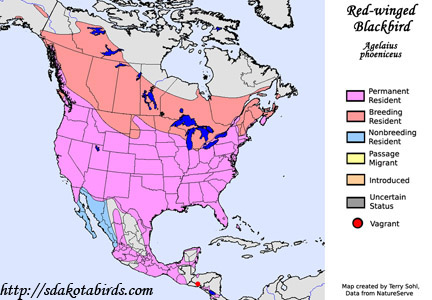 |
| South Dakota Status: Very common summer breeding resident and migrant. Uncommon in the winter |
Additional Red-winged Blackbird Photos
Click for a higher-resolution version of these photos
